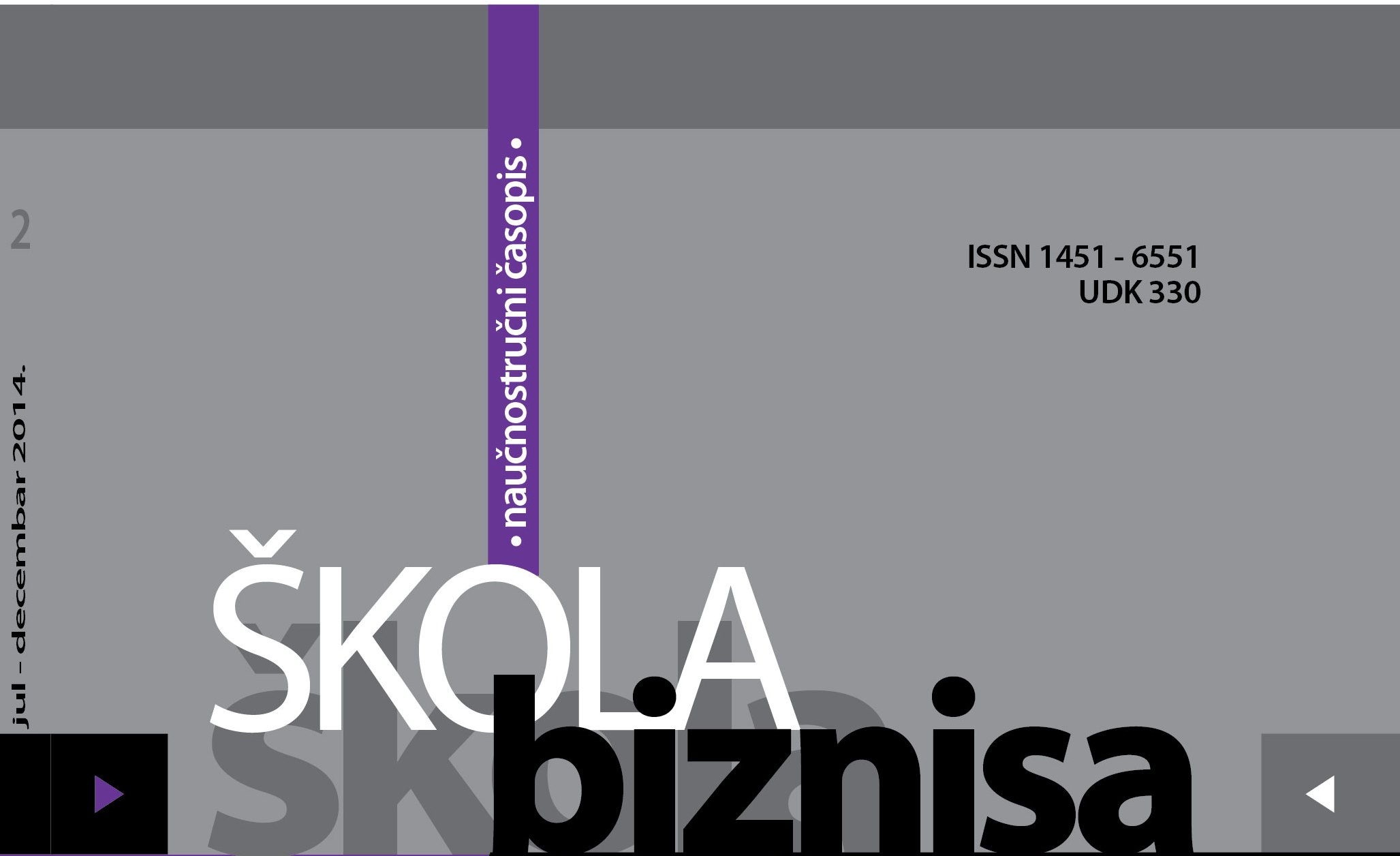THE INFLUENCE OF MAIN MACROECONOMIC INDICATORS ON BANKING SECTOR LIQUIDITY IN SERBIA
Abstract
The banking sector in Serbia can be characterized as a very liquid one. Main reasons for the high liquidity are the decrease in credit lending activity of banks and increase of the share of NPLs (i.e. non-performing loans) in the total number of loans in the post-crisis period. The aim of this paper is to analyze the influence of the initial impact of the global economic crisis as well as the influence of main macroeconomic indicators of the banking sector liquidity. The research results support the thesis that the growth of the GDP, the decline in unemployment, reduction of the balance of payments deficit and reduction of inflation have an impact on reducing liquidity. The general conclusion is that the Republic of Serbia needs to implement economic measures in this direction. This would take the liquidity of the sector to an optimum level.
References
Basel Committee on Banking Supervision, Working Group on Liquidity. (2008). Principles for Sound Liquidity Risk Management and Supervision. Bank for International Settlements.
De Santis, R. A., & Surico, P. (2013). Bank lending and monetary transmission in the euro area. Economic Policy, 28 (75), 423–457.
Deléchat, C., Henao, C., Muthoora, P., & Vtyurina, S. (2012). The Determinants of Banks’ Liquidity Buffers in Central America. International Monetary Fund.
Fecht, F., Nyborg, K. G., & Rocholl, J. (2008). The price of liquidity: Bank characteristics and market conditions. Discussion paper Series 1 / Volkswirtschaftliches Forschungszentrum der Deutschen Bundesbank.
Handorf, W.C. (2014). The cost of bank liquidity. Journal of Banking Regulation, 15 (1), 1–13.
Lucchetta, M. (2007). What Do Data Say About Monetary Policy, Bank Liquidity and Bank Risk Taking? Economic Notes, 36 (2), 189–203.
Mishkin, F. S. (2009). Is Monetary Policy Effective During Financial Crises? NBER Working Paper.
Moore, W. (2009). How do financial crises affect commercial bank liquidity? Evidence from Latin America and the Caribbean.
Newbold, P., Carlson, W. L., & Thorne, B. (2010). Statistika za poslovanje i ekonomiju. Zagreb: MATE.
Račić, Ž. (2013). Komparativna analiza uticaja veličine banaka na izloženost HPR-a kamatnom riziku: razvijeno finansijsko tržište vs. finansijsko tržište Republike Srbije. Škola biznisa, 1, 1–11. doi:10.5937/skolbiz1301001R.
Račić, Ž., Stanišić, N., & Račić, M. (2014). A Comparative Analysis of the Determinants of Interest Rate Risk Using the Example of Banks from Developed and Developing Financial Markets. Engineering Economics, 25 (4), 395–400.
Rauch, C., Steffen, S., Hackethal, A., & Tyrell, M. (2010). Determinants of Bank Liquidity Creation. Preuzeto sa http://ssrn.com/abstract=1343595.
Trenca, I., Petria, N., Mutu, S., & Corovei, E. (2012). Evaluating the liquidity determinats in the central and eastern European banking system. Finance-Challenges of the Future, 85–90.
Valla, N., Saes-Escorbiac, B., & Tiesset, M. (2006). Bank liquidity and financial stability. Banque de France Financial Stability Review, 89–104.
Vodová, P. (2011). Determinants of Commercial Bank’s Liquidity in Slovakia. Czech Science Foundation. (Project GACR P403/11/P243).
Vodová, P. (2012). Liquidity of Czech and Slovak Commercial Banks. Acta Universitatis agriculturae et silviculturae mendelianae brunensis, 60 (7), 463–476.
Vodová, P. (2013). Determinants which affect liquid assets ratio of Czech and Slovak commercial banks. Financial Assets and Investing, 1.
Vodová, P. (2014). Determinants of Commercial Bank Liquidity In Hungary. e-Finanse, 9 (3), 64–71.
- Authors retain copyright and grant the journal right of first publication with the work simultaneously licensed under a Creative Commons Attribution License that allows others to share the work with an acknowledgement of the work's authorship and initial publication in this journal.
- Authors are able to enter into separate, additional contractual arrangements for the non-exclusive distribution of the journal's published version of the work (e.g., post it to an institutional repository or publish it in a book), with an acknowledgement of its initial publication in this journal.
- Authors are permitted and encouraged to post their work online (e.g., in institutional repositories or on their website) prior to and during the submission process, as it can lead to productive exchanges, as well as earlier and greater citation of published work (See The Effect of Open Access).

